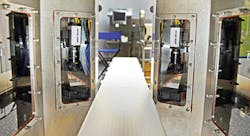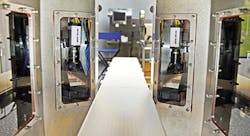Industrial Automation: Multiple camera system inspects print and labels at high speed
Traditional methods of inspecting round, unoriented containers involve capturing multiple images of the part, unwrapping these images and then compositing (or stitching) them together. This involves interpolation of key points between images using known data to estimate values at unknown points. After a final image is composited, machine vision software can then be used to measure the position of labels, confirm features, and read barcodes that may be present.
"Image stitching methods are the most effective way of making precision measurements on label positioning, including the distance between two labels on a container," says Jim Roberts, Head of Sales and Marketing at Mettler Toledo CI-Vision (Aurora, IL, USA; www.mt.com). Indeed, Mettler Toledo is well-known for manufacturing such systems.
"Although effective," says Roberts, "image stitching methods require four cameras precisely positioned so their fields of view are precisely aligned. The alignment and calibration procedure can be time consuming and difficult to manage, especially in the field. In the event a key feature, such as a barcode, overlaps two images there is an increased risk of a false reject when the stitching algorithm does not precisely align the two segments of the code.
As an alternative to this approach, image paneling systems also use a number of cameras to capture multiple images of parts that are then unwrapped by the host computer. Rather than perform image stitching, however, these systems analyze the image data on each of the separate labels or containers individually. This allows systems to operate at a higher throughput than stitching systems and makes them more effective at identifying symbols such as bar codes at high-speed. However, since images are not stitched together, they will be less accurate in measuring the distance between labels on the container.
Roberts points out, however, that in approximately 80% of applications the customer does not require such measurements, since many containers will have a single label - the features and barcodes of which must be read at high-speed.
This is the concept behind the company's latest print and label inspection system, the Mosaic Compact. To reduce the footprint of the system to 0.71m x 0.66m, Mettler Toledo CI-Vision has taken a different approach than in its previous generation of Mosaic systems. In these systems, six cameras, each with their own separate light sources, were mounted horizontally and used to capture multiple images of the parts as they passed through the imaging station.
In the Mosaic Compact design, six GigE cameras are mounted vertically. Images from the product being inspected are reflected from mirrors positioned at 45° angles into the cameras field of view.
"To accommodate products of different sizes, we mounted the cameras and mirrors on a stage that are moved vertically either manually or automatically under control of the systems host PC," says Roberts.
Rather than use multiple LED flat panel lights to illuminate the containers, a single flat panel white LED is placed above the field of view of all six cameras. Individual rows and columns of LEDs within the panel are offset at different angles to ensure that the sides of objects are correctly illuminated as they pass through the system. The system also allows for independent control of inner and outer rings of LEDs on the panel lights, which further increases lighting options.
In operation, image data from all six of the GigE cameras are captured simultaneously and transferred to the PC for processing.
Image analysis is then performed on these images using Mettler Toledo CI-Vision's CIVCore software. This software has been developed to leverage a number of off-the-shelf image processing packages. "If, for example," says Roberts, "it is necessary to find key features on a label or package, Cognex's PatMax algorithm may be used. What is unique is to have the choice to select the best algorithm for the application."
Results of image inspection are then used to trigger either pneumatic or electro-mechanical actuators to reject the part further along the production line. This is accomplished by triggering a relay output from a hardwired PLC.
Already, installation of the Mosaic Compact system has saved one manufacturer hundreds of thousands of dollars. "The production line was running at 150ppm, every hour of very day. Reducing the false rejection rate from 3 to 0.05%, the savings on a single production line were estimated to be $300,000 annually" says Roberts.

